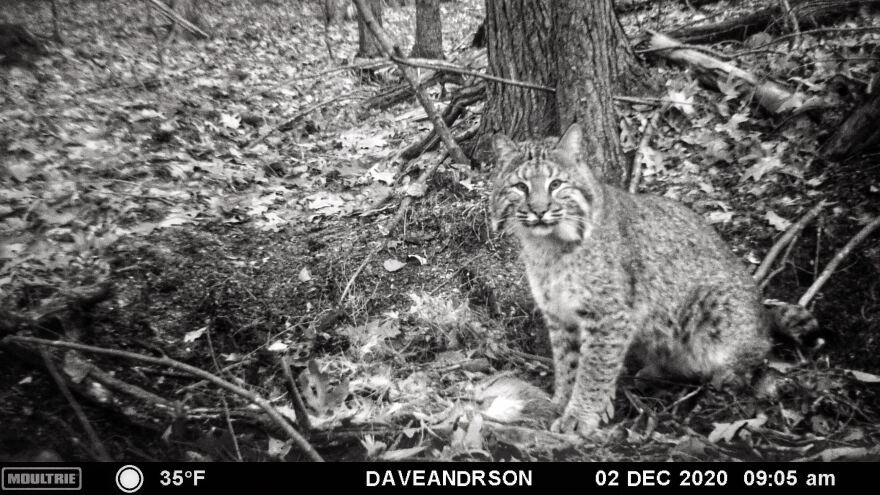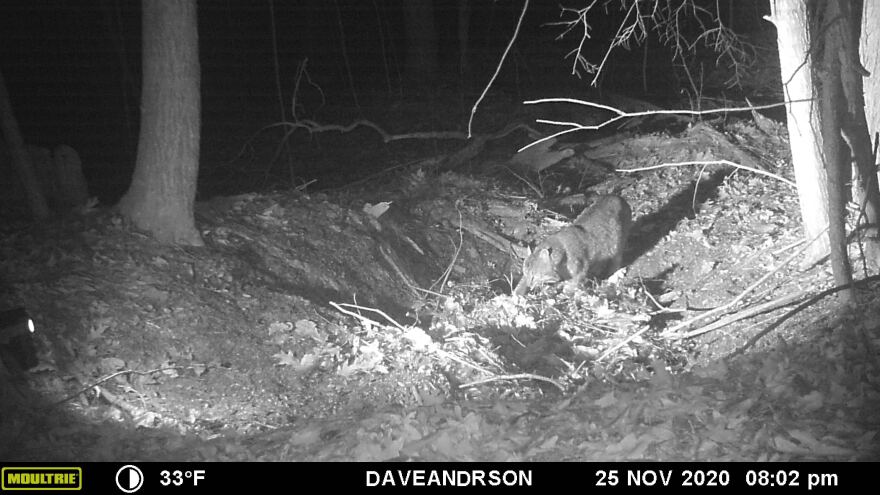
The number of images of New Hampshire bobcats on social media makes us wonder if there are more New Hampshire bobcats. Or is the growing number of people owning game cameras and posting photos online just making it seem like there’s a boom in the bobcat population?
Dave Anderson is part of the trend. “I found a freshly euthanized deer carcass one winter, so I put together some wildlife cameras and got great photos of a bobcat uncovering it, feeding on it, retrieving it, and scent marking it to protect the site,” he says. “It was fascinating to watch.”

“They are a beautiful species. They have their own charisma,” says Patrick Tate, a furrier wildlife biologist with the NH Department of Fish and Game. “You can see a bobcat slowly moving across the landscape. Sit for hours. And then he flips a switch where you see his almost superhero abilities to run around the yard, bounce off three different objects and catch the squirrel out of the air.”
So are there more bobcats in the state or more wildlife cameras?

Tate says it’s both. We are seeing more bobcats in more places than ever thanks to modern technology. And Tate says there’s a 10 to 12 percent increase per year in the bobcat population, based on bobcat mortality data. Nearby states with wildcat hunting and trapping seasons report similar increases. New Hampshire has not had a wildcat hunting and trapping season since 1989.
NH Fish and Game takes a DNA sample from every dead bobcat, and that data shows that there is greater genetic diversity in bobcats today than there was in the 1950s. That means a more adaptable and resilient population.
“We have wildcats from border to border in New Hampshire; from the Massachusetts border to the Canadian border,” says Tate. “And according to the scientific literature, the Cordillera Blanca is the rough dividing line between the two different subspecies of bobcat that we have. They’re a generalist species, which means they can adapt to various climates, and that’s why they’re all over North America in the lower 48 — almost every state has bobcats.”
Bobcats are also generalists when it comes to their diet. They will eat anything from the size of a field mouse to the size of a white-tailed deer, and even reptiles and birds. And don’t forget the on the roof of the Burger King in Stratham a few years ago!
They stalk their prey, but are also adept at stalking and ambushing. “They’re not tree climbers or tree hunters, so they don’t need their tails for balance,” says Tate.

That explains the short wavy tail. However, they can still climb and jump, and run up to 30 miles per hour.
Bobcats are bigger than you think. “What I consider a large male bobcat weighs more than 30 pounds, although I have held a 45-pound bobcat that came out of the Tuftonboro area of New Hampshire,” says Tate.
Male bobcats are twice the size of females and their home range is also twice as large. Females have a home range of about 12 square miles, males closer to 30 square miles. Male bobcats allow other males to overlap in their home range, but females will not allow them to overlap with another female’s territory. Of course, if a female’s home range overlaps with that of a male, the problem is less.
Male and female bobcats do not stick together. “They’ll mate, and then she’ll go off and go do her thing,” says Tate. “And if she’s still in heat, [she may] mate with a completely different male. So kittens can have different fathers than their siblings.”
With the bobcat population growing 10 to 12 percent per year, and bobcats already existing throughout the state, what is the chance that we will eventually outgrow the available territory for bobcats?
“It’s unavoidable because we have a limited amount of landscape,” says Tate. “Food limitation is generally what limits our wildlife in the state. That’s what makes home ranks rise and fall in any given year. But given our robust deer population, our robust small mammal population in the landscape, it’s going to be several years, in my opinion, before we see any kind of major food-related issue.”
New technologies such as wildlife cameras give us an exciting opportunity to observe wildlife, especially the bobcat that lives quietly next to us.
Special thanks to Patrick Tate of New Hampshire Fish & Game.
Something Wild is a joint production of NH Audubon, The Forest Society and NHPR.
